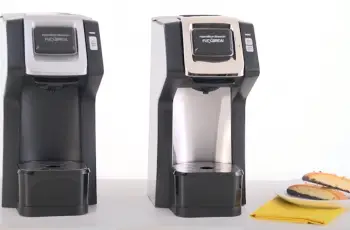Unless you have a well-stocked pantry at all times you may find yourself all out of distilled white vinegar when it comes time to clean the coffee maker. I know that many people go seemingly forever between coffee maker cleanings and when the bug strikes to get this task off your to-do list you want to take advantage of it. If however you only have apple cider vinegar on hand (or baking soda) please do your best to hold off until you can get to the store and buy a jug of regular old white vinegar.
If you can’t wait then yes, you can use apple cider vinegar to clean your coffee maker. It works just fine. The only problem is it costs more to use and you will have to rinse your machine out a few extra cycles to get the taste out.
Cleaning With Apple Cider Vinegar Leaves Tannins
Yes, you could clean your coffee maker with the apple cider variety. It has adequate acidic pH levels to get the job done but the tannins will leave behind a taste in your coffee maker that will not rinse off as quickly and easily as you’d like.
Some people complain about the smell of white vinegar in their home but this is easy to dissipate and rinse from your machine. Apple cider vinegar will leave a lingering taste that will make your coffee a bit underperforming for some time.
Make sure you run a water and vinegar cycle through your coffee machine just like you normally would. I like to use a 50/50 ratio for the first run and then if I do more runs I pull back a bit.
The trick to getting the smell and taste out is to run a lot more plain water cycles to rinse your system. With plain vinegar, it’s easier to get back to a “blank” taste but it will take longer if you use apple cider vinegar.
Additional Tips
- Remember to remove the coffee filter after every use. Don’t let it sit there until the next morning – it can be a breeding ground for bacteria and mold.
- Don’t use the carafe to fill up the water reserve – especially if you don’t clean it after each use.
- If you use K-cups, be sure to remove those after each use as well. There may be additional cleaning needed around the K-cup area to remove excess grounds. A toothbrush may work well for those hard-to-reach areas.
- Read up on filter life. For optimal performance, you may need to change the filter more often than you think.
- Set a reminder. Use your phone, put it on a calendar, or do it every first of the month. It’s important to have a routine.
You Can Also Clean A French Press with Vinegar
Every now and then I like to pull out my favorite french press coffee maker and soak the fine mesh plunger in the same apple cider vinegar solution. It does a good job and keeping those tiny holes clean.
On a related note, you can check out this post for another good way of cleaning your coffee maker when you don’t have white vinegar on hand. It takes a lot of lemons though – be forewarned.
Here are Some Other Ways to Clean a Coffee Machine
There are many easy ways to clean the coffee maker.
Regular Cleaning
This refers to everyday cleaning or every time you use the coffee maker.
- Wash the carafe and the coffee filter after every use.
- Always follow manufacturers’ instructions whether parts are dishwasher safe or hand washes only.
- Always check parts of your coffee maker.
- If you keep a coffee maker inside a cupboard, always make sure that all parts are dry to avoid any mold and mildew build-up.
Deep Cleaning
This refers to a scheduled procedure when the coffee maker undergoes a complete cleaning.
Use Baking Soda: You can also use baking soda when cleaning your coffee maker although you do have to be careful using this method.
The process is similar to using vinegar. Mix baking soda with lukewarm water. Always use lukewarm water to completely dissolve the baking soda. Pour the baking soda solution into the water chamber. Press the brew button and run a full brewing cycle. Throw away the water. To wash the coffee maker, fill the water chamber with a full brewing cycle. Run a full brew. Watch if the water is clear or not. Often, it will take two full brewing cycles to completely wash off the baking soda solution.
Use Vinegar and Salt – Mix water, vinegar and add some salt. Salt is a natural antibacterial. By adding salt, it will help you disinfect the coffee maker especially if mold and mildew had grown in the tube the carries the water from the chamber to the filter.
Denture Tablets – Many coffee maker owners agree that denture tablets are great cleaners. It helps remove calcified content and freshens up the coffee maker to deliver great-tasting coffee, like a new coffee maker.
Fill the carafe with water. Dissolve 1 or 2 denture tablets. You can use even generic denture tablets. Pour the denture tablet solution in the water chamber. Run a full brewing cycle. Discard the used water. Fill the water chamber again and run a full brewing cycle to wash off any remaining solution. Unlike vinegar and baking soda, you only need one full brewing cycle wash to clean up the coffee maker.
Are Dedicated Coffee Maker Descalers Better Than Vinegar?
Yes, obviously the acidic properties of vinegar can clean the crud out of a coffee pot but in the real world, you have to do this a lot to keep things as clean as possible. The best way to keep a coffee maker clean is to use a dedicated appliance cleaner designed to break up all the calcium and mineral deposits. If you are using unfiltered water, especially water from a well, you may end up with larger particle debris clogging up your system.
There is a very inexpensive product called CleanCaf that you can pick up which will be better at descaling your machine but it is also formulated to cut through the coffee oils that buildup over time. These oils are the weak spot with vinegar as vinegar doesn’t clean coffee oils up very well. CleanCaf isn’t the only option either. There are a few other options listed here.



